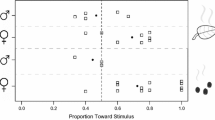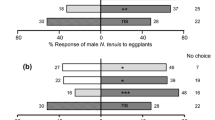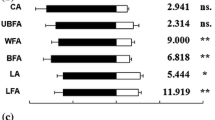Abstract
Sixth instars of the parsnip webworm, Depressaria pastinacella, orient by olfaction to bud, male flowers, and female flowers of their primary host plant, Pastinaca sativa. Because octyl acetate and octyl butyrate are characteristic of tissues consumed by the sixth instar, we investigated the influence of these esters on webworm feeding behavior and chemo-orientation. Although octyl acetate and octyl butyrate are feeding deterrents, and octyl butyrate is an olfactory repellent, octyl acetate serves as an olfactory attractant. In olfactometers, webworms do not show a preference when given a choice between octyl acetate and host plant tissues. These findings suggest that octyl acetate is a sufficient cue for olfactory orientation. Such behavior may explain differences in the relative abundance of these esters observed among populations of wild parsnip under differential selection pressure from these insects.
Similar content being viewed by others
REFERENCES
Berenbaum, M. and Neal, J. 1985. Synergism between myristicin and xanthotoxin, a naturally cooccurring plant toxicant. J. Chem. Ecol. 11:1349–1358.
Berenbaum, M. R. and Zangerl, A. R. 1991. Acquisition of a native host plant by an introduced oligophagous herbivore. Oikos 62:153–159.
Berenbaum, M. R. and Zangerl, A. R. 1992. Genetics of physiological and behavioral resistance to host furanocoumarins in the parsnip webworm. Evolution 46:1373–1384.
Berenbaum, M. R., Zangerl, A. R., and Nitao, J. K. 1984. Furanocoumarins in the seeds of wild and cultivated parsnip (Pastinaca sativa). Phytochemistry 23:1809–1810.
Berenbaum, M. R., Zangerl, A. R., and Nitao, J. K. 1986. Constraints on chemical coevolution: wild parsnips and the parsnip webworm. Evolution 40:1215–1228.
Berenbaum, M. R., Zangerl, A. R., and Lee, K. 1989. Chemical barriers to adaptation by a specialist herbivore. Oecologia 80:501–506. PARSNIP WEBWORM RESPONSES TO VOLATILES 2201
Bicchi, C., DÍAmato, A., Frattini, C., Cappelletti, E., Caniato, R., and Filippini, R. 1990. Chemical diversity of the contents from the secretory structures of Heracleum sphondylium subsp. sphondylium. Phytochemistry 6:1883–1887.
Carroll, M. J., Zangerl, A. R., and Berenbaum, M. R. 2000. Heritability estimates for octyl acetate and octyl butyrate in the mature fruit of the wild parsnip. J. Hered. 91:68–71.
Cianfrogna, J. A., Zangerl, A. R., and Berenbaum, M. R. 2002. Effects of furanocoumatins on feeding behavior of parsnip webworms Depressaria pastinacella. J. Chem. Ecol. 28:1365–1375.
Feeny, P. 1976. Plant apparency and chemical defense, pp. 1–40, in J.W. Wallace, and R. L. Mansell, (eds). Biochemical Interaction Between Plants and Insects, Plenum, New York.
Gorder, N. K. and Mertens, J. W. 1984. Life history of the parsnip webworm Depressaria pastinacella (Lepidoptera: Oecophoridae), in central Iowa. Ann. Entomol. Soc. Am. 77:568–573.
Green, E. S., Zangerl, A. R., and Berenbaum, M. R. 1998. Reduced aggressive behavior: a benefit of silk-spinning in the parsnip webworm, Depressaria pastinacella (Lepidoptera: Oecophoridae). J. Insect Behav. 11:761–772.
Nitao, J. K. and Berenbaum, M. R. 1988. Laboratory rearing of the parsnip webworm Depressaria pastinacella (Lepidoptera: Oecophoridae). Annu. Rev. Entomol. Soc. Am. 81:485–487.
Riley, C. V. 1888. The parsnip webworm. Insect Life 1:94–98.
Stahl, E. and Kubeczka, K. H. 1979. Über ätherische Öle der Apiaceae (Umbelliferae). VI. Untersuchungen zum Vorkommen von Chemotypen bei Pastinaca sativa L. Planta Med. 37:49–56.
Visser, J. 1986. Host odor perception in phytophagous insects. Annu. Rev. Entomol. Soc. Am. 31:121–144.
Zangerl, A. R., Green, E. S., Lampman, R. L., and Berenbaum, M. R. 1997. Phenological changes in primary and secondary chemistry of reproductive parts in wild parsnip. Phytochemistry 44:825–831.
Author information
Authors and Affiliations
Corresponding author
Rights and permissions
About this article
Cite this article
Carroll, M.J., Berenbaum, M.R. Behavioral Responses of the Parsnip Webworm to Host Plant Volatiles. J Chem Ecol 28, 2191–2201 (2002). https://doi.org/10.1023/A:1021093114663
Issue Date:
DOI: https://doi.org/10.1023/A:1021093114663




